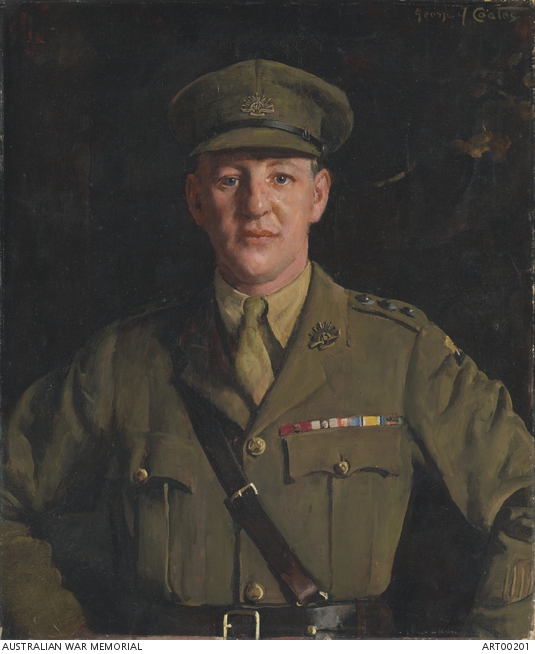| Places | |
|---|---|
| Accession Number | ART00201 |
| Collection type | Art |
| Measurement | Overall: 76.8 cm x 63.3 cm; Framed: 87 cm x 74 cm x 8.5 cm |
| Object type | Painting |
| Physical description | oil on canvas |
| Location | Main Bld: Hall of Valour: Main Hall: Western Art Wall |
| Maker |
Coates, George |
| Place made | Australia: Victoria, Melbourne |
| Date made | 1921 |
| Conflict |
Period 1920-1929 First World War, 1914-1918 |
| Copyright |
Item copyright: Copyright expired - public domain
|
Captain Albert Jacka

Portrait of Captain Albert Jacka, VC, MC and Bar, 14 Battalion AIF, 1st Australian Imperial Force. After training in Egypt, Jacka's battalion landed at Gallipoli on 26 April 1915. Just over three weeks later on 19 May, with the ANZACs now entrenched above the beaches, the Turks launched large-scale frontal assaults against their positions. Some Turks captured a small section of trench at Courtney's Post. Early attempts to drive them out failed, until Jacka, taking advantage of a diversion created by bomb throwers at one end of the Turkish position, leapt in, killing most of the occupants. For this he was awarded Australia's first Victoria Cross of the First World War. Jacka quickly became famous and his likeness was used on recruiting posters and his exploits featured regularly in newspapers, particularly in his native Victoria. He began a rapid rise through the ranks, finally becoming a captain in March 1917. Jacka, having risen no higher, has been attributed to his frequent disputes with superior officers. After Gallipoli the 14th Battalion was shipped to France, where, at Pozières in August 1916 and at Bullecourt in 1917 he won the Military Cross and a bar to that award. The Australian official historian, Charles Bean, described his actions at Pozières, during which he recaptured a section of trench, freed a group of recently captured Australians and forced the surrender of some fifty Germans, as the most dramatic and effective act of individual audacity in the history of the AIF. He was severely wounded during this action and was hit by a sniper's bullet in July 1917. On each occasion he returned to the front, always furthering his reputation as one of the AIFs most respected warriors. In May 1918 he received the wound that ended his combat career, this time during a German gas bombardment near Villers-Bretonneux. Jacka returned to Australia in September 1919. Greeted by a large crowd upon his return, Jacka was described in one newspaper as the symbol of the spirit of the ANZACs.
George Coates (1869-1930) studied painting under L. Bernard Hall between 1895-96 acquiring both respect for the painter's craft and the approach of the Munich School. He won a travelling scholarship in 1896 and went to London next year before moving to Paris, where he worked at the Académie Julian and studied under Jean Paul Laurens. In Paris Coates renewed an acquaintance with a fellow art student, Dora Meeson (1869-1955) who later became his wife. Coates and Meeson established themselves in Chelsea, London where they became members of an extensive circle of Australian expatriate artists. Coates established himself as one of London's leading portrait painters, where he lived until returning to Australia in 1921, and his realism and representational style emphasized a harmonious range of low tones, with a detailed and painstaking approach.
Share this page
Related information
Conflicts
Places
Subjects
Related Objects
- Victoria Cross: Lance Corporal Albert Jacka, 14 Battalion, AIF
- Identity disc: Lieutenant Albert Jacka, 14 Battalion AIF
- Military Cross and bar : Captain Albert Jacka, 14 Battalion, AIF
- 1914-15 Star : Sergeant Albert Jacka, 14 Battalion, AIF
- British War Medal 1914-20 : Captain Albert Jacka, 14 Battalion, AIF
- Victory Medal : Captain Albert Jacka, 14 Battalion, AIF
- Luger P08 Pistol : Captain A Jacka, 14 Battalion, AIF
- Victoria Cross ribbon bar : Captain A Jacka, 14 Battalion, AIF
- Luger P08 Pistol Firing Pin: Captain A Jacka, 14 Battalion, AIF
